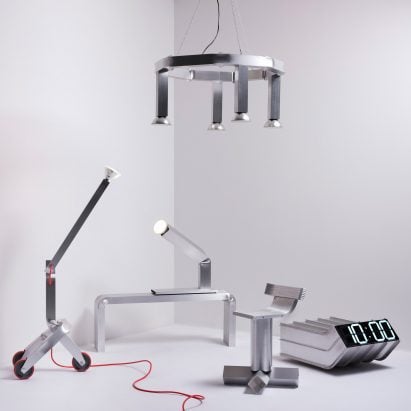Scottish designer David Taylor unveiled 25 handcrafted aluminium objects during Stockholm Design Week. Here, the trained silversmith reveals the secrets behind his process.
Presented by auction house Bukowskis, Taylor’s Special Effects collection included lamps and candelabras formed of bent metal tubes and furniture embellished with neat line patterns.
The formal simplicity of these designs belies the highly technical process of making them.
David Taylor created 25 pieces for the Special Effects exhibition and auction
“When you stand in front of a piece, it’s very simple, clear and distinct,” Taylor told Dezeen. “But it’s a lot more advanced than it looks.”
One of the biggest challenges with crafting aluminium, Taylor explained, is that it doesn’t change colour when heated. So unlike silver and other metals, it’s hard to know when it has reached the correct temperature for moulding.
Taylor discovered that ink could work as a substitute. He uses a specific marker pen to add dots to key points on the material surface. When the ink disappears, it tells him when the metal is ready to be worked.
Works on show included a two-metre-high floor lamp with precise 90-degree bends
“That’s the secret sauce,” Taylor said.
“Aluminium crumbles if you heat it too much,” he explained. “It’s also important that the heat is evenly distributed; if the pipe is warm on one side and cold on the other, [the material] will move to the warmer side.”
Taylor has been based in Sweden since 1994, when he began training as a silversmith at Konstfack in Stockholm, one of Scandinavia’s most prestigious universities for art and design.
Other works included a chair with splayed legs and a four-armed candelabra
After the 2008 financial crisis, when the market for silver dried up, the designer began experimenting with cheaper materials like concrete. Examples include his Crowd Candlesticks and Walk the Walk accessories.
In aluminium, Taylor found a material that shares some qualities with silver. But as it’s far cheaper, it gives him greater scope to experiment with different techniques.
“It’s like silversmithing on steroids because you don’t have to plan,” he said.
“I can get two square metres of aluminium for the same amount of money as a small piece of silver, so I can afford to work on a trial and error basis. It’s liberating.”
David Taylor produces his designs at a studio in Mellösa
A technique for bending square-profile aluminium tubes has become Taylor’s signature, as seen on the Dezeen Award-winning Knuckle lights he launched with Hem in 2023.
Special Effects saw him push this technique further than before, with works including a diamond-shaped wall mirror, a chair with splayed legs and a two-metre-high floor lamp featuring precise 90-degree bends.
The metal swells and buckles at the joints, revealing the stress placed on it during the bend.
“That’s what the material does to defend itself,” Taylor explained.
“When you work with a material like I do, the relationship becomes quite personal,” he added.
“It’s like getting to know somebody. Everyone reacts in different ways, you can push them to some limits but not to others. You develop this rapport.”
Taylor uses a marker pen to help him judge the temperature for bending his aluminium tubes
Taylor produces his designs at a studio in Mellösa, a lakeside town approximately two hours drive from Stockholm.
His approach is driven by the process rather than the end result. He said it is like Sudoku – the numbers puzzle he often plays when he needs to clear his head between tasks.
“I work in a process that evolves in the same way as Sudoku,” he said. “Because every time you do something, you get a hint about what direction you should take in the next stage.”
“I really enjoy the physical action of making things,” he added. “Once it’s made, I lose interest in it.”
Taylor said the making process is “like silversmithing on steroids”
Many of the larger, load-bearing furniture pieces are debossed with intricate patterns – another reference to Taylor’s silversmithing skills.
These patterns are functional as well as aesthetic. “The decoration adds a lot of strength,” Taylor said.
Like the bends, these patterns lend the aluminium a sense of softness that is not inherent to the material.
“This isn’t Berlin techno; it’s soft and approachable,” Taylor stated.
Some pieces feature debossed surface patterns and colour finishes
The only technique the designer doesn’t carry out himself is the addition of colour. An external company was responsible for the anodising that produced a red room divider, a brown wall relief and three turquoise pieces.
In everything else, Taylor prefers to have full control over the creative process.
“In my workshop, I’m the king,” he said. “I don’t need to speak to anyone about anything in there.”
“Outside, I follow the same rules as everyone else. I drive according to the speed limit. I don’t need too much sweet food. But in this space, nobody tells me anything, because I know the answer.”
Special Effects was on show at Bukowskis from 4 to 7 February as part of Stockholm Design Week 2025. See Dezeen Events Guide for an up-to-date list of architecture and design events around the world.
The post Crafting aluminium is “like silversmithing on steroids” says David Taylor appeared first on Dezeen.
